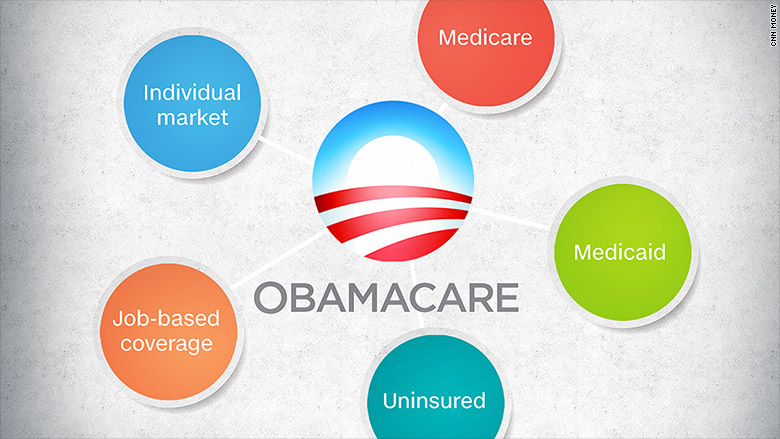 It’s not just for the 20 million people who have health insurance through the individual Obamacare exchanges or Medicaid expansion.
It’s not just for the 20 million people who have health insurance through the individual Obamacare exchanges or Medicaid expansion.
Under Obamacare, senior citizens pay less for Medicare coverage and for their prescription drugs. Many Americans have received free contraceptives, mammograms, colonoscopies and cholesterol tests. And small business employees with older and sicker workers have not been slapped with super-high premiums.
«The ACA made changes in every part of the health care system,» said Larry Levitt, senior vice president at the Kaiser Family Foundation, of the Affordable Care Act. «Virtually everyone has been touched by the ACA. »
President-elect Donald Trump and congressional Republicans have vowed to swiftly repeal Obamacare. They plan to start with the provisions that affect spending and revenues — including the federal subsidies, Medicaid expansion, taxes and mandates that all individuals obtain coverage and large employees provide it. That will require only a majority of votes in the Senate. But Republicans have promised to eventually undo all of President Obama’s signature health reform law, save for the provision allowing children under age 26 to stay on their parents’ plan.
Here’s how Obamacare and its full repeal would affect all Americans:
Medicare
Dismantling Obamacare would likely mean higher premiums, deductibles and cost-sharing for the 57 million senior citizens and disabled Americans enrolled in the program. It would also bring back the infamous «donut hole» in Medicare’s prescription drug coverage.
The health reform law made many changes to Medicare. It slowed the growth of payment rates to hospitals and other providers, reduced payments to Medicare Advantage plans and improved benefits for enrollees. Repealing Obamacare would increase Medicare spending by $802 billion over 10 years, according to estimates by the non-partisan Congressional Budget Office.
As a result, Medicare beneficiaries would pay more because premiums and deductibles are tied to the growth of federal outlays. So seniors would face higher deductibles and co-payments for their Part A, which covers hospital stays, and higher premiums and deductibles for Part B, which pays for doctor visits and other services. The White House estimated that the typical Medicare beneficiary is paying about $700 less in premium and cost sharing this year because of slower growth in costs.
Under Obamacare, Medicare enrollees receive free preventative benefits, such as screenings for breast and colorectal cancer, heart disease and diabetes. This provision would disappear under a full repeal.
Readers: How has Obamacare affected you? How should President-elect Trump reform health care? Email tami.luhby@cnn.com and we may cite you in an upcoming story.
Also, Obamacare called for closing the gap in Medicare’s drug coverage in stages, completely eliminating it by 2020. Senior citizens have to pay more for drugs while they are in the donut hole. For 2016, the gap begins when enrollees and their insurers have spent $3,310 for medication and ends after they hit $4,850 in costs. Since Obamacare was passed in 2010, more than 11 million people have saved an average of more than $2,100 a person on prescription drugs, according to the White House.
The donut hole would return if Obamacare were repealed.
Higher-income enrollees, however, would see some financial benefit from repeal. Obamacare froze the threshold for the Medicare premium surcharge at $85,000 for individuals and $170,000 for couples, so more people have become subject to it. The law also added a premium surcharge on drug coverage for wealthier beneficiaries.
Related: Obamacare under President Trump: What happens next?
Employer-sponsored insurance
Say goodbye to the employer mandate if Obamacare is repealed. Companies with at least 50 employees would no longer be required to provide affordable insurance to their staffers who work more than 30 hours a week.
This likely wouldn’t have a major impact on the 150 million workers who are insured through their jobs since most larger employers already offer coverage for full-time workers, Levitt said.
However, setting the bar at 30 hours a week prompted some employers to extend coverage to more of their staff, since many companies had considered that threshold to be part-time. If repealed, companies could opt to cover only those working at least 35 or 40 hours a week, leaving some people uninsured.
Also, companies would no longer have to keep children on their parents’ plans until they turn 26. This has proved to be one of the more popular Obamacare provisions, with 2.3 million Americans ages 19 to 25 signing up between 2010 and the start of open enrollment in 2013, according to the White House’s most recent figure. (Trump has said he may keep this policy.)
Workers, however, may have to start paying again for contraceptives and preventative screenings, such as colonoscopies and mammograms. Obamacare requires these to be provided free-of-charge.
Obamacare also prohibits employers from imposing annual or lifetime limits on benefits and caps out-of-pocket spending (to $6,850 for single workers in 2016). But most companies’ policies already met these criteria.
Repealing Obamacare could have a bigger hit on employees who work at companies with fewer than 50 workers.
They enjoyed many of the benefits Obamacare brought to the individual market. Insurers could no longer ban workers with pre-existing conditions or ask them to pay more. It required plans to cover an array of benefits, including maternity, mental health and prescription drugs. And it limited insurers from charging older workers premiums more than three times those of younger workers. All this could be reversed under repeal.
Related: How Trump may cover Americans with pre-existing conditions
Individual market
Obamacare has had the largest impact on the individual market, which was largely unregulated prior to the health reform law.
It sought to make health insurance more accessible and affordable in a number of ways. It required insurers to cover people with pre-existing conditions and banned them from charging the sick more. The law ended the practice of insurers imposing annual or lifetime caps on benefits, and it also placed limits on annual out-of-pocket spending. It mandated that individual insurance cover an array of benefits, including medication, maternity and mental health. It prevented insurers from charging women more and restricted premiums for older folks at no more than three times those of young adults.






